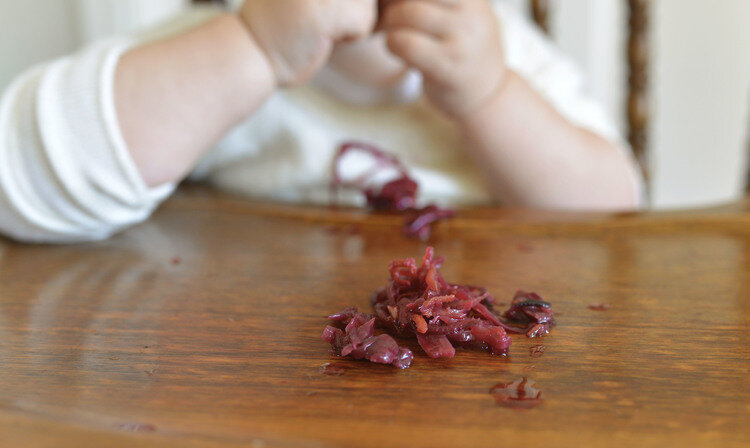Why Your Baby Should Be Eating Fermented Foods
Offering children a variety of foods helps to broaden their palates, but "sour" is an important flavour that isn't usually given to babies in western cultures. Traditionally fermented foods are a wonderful way to introduce sour flavours. Many children consume highly processed foods that are overwhelmingly sweet and salty. Giving fermented foods to babies from an early age once they've started solids can actually lessen their desire to over consume sweet foods.
Eating probiotic rich foods is one of the best things you can do for the health of your child. Breast milk contains healthy fat & bacteria, but the food most commonly fed babies lacks both! Fermented foods really are “food as medicine”. They aid digestion, support immunity, and actually increase the nutritional content of foods. They are especially recommended for babies born c-section, babies who have been given antibiotics, those with gas, constipation, or other tummy troubles.
We're made up of more bacteria cells than we are of human cells and the "good guys" propagate when we consume fermented foods. Probiotic supplements can be fantastic, but they only offer a few different strains of bacteria. Fermented foods offer a much more diverse range of good bacteria and increase a wider variety of the "good guys" in your gut.
How to start?
Introduce fermented foods very gradually, starting with very small amounts. They may make a “sour” face, but then might surprise you by reaching for more right away. It is just a new flavor for them to adjust to. It may require several offerings for your little one to acquire the taste for them. If they initially reject the flavour, try offering it again in about a week or so.
Store bought
Traditionally fermented foods are found in the refrigerated section of the store. The sauerkraut or pickles that are found on store shelves and sold at room temperature are soaked in a vinegar brine and do not have the same health benefits.
Homemade
At home I’ve made lacto-fermented root vegetables, sauerkraut, fermented cranberries, preserved lemons, traditional pickles, fermented relish, kombucha and kefir. Once you get into it, it’s incredibly easy and it makes you feel pretty crafty in the kitchen. Making ferments at home also allows me to ensure that high quality salt is used.
Methods of fermenting
Salt vs starter
Vegetables can be fermented with salt, a starter like whey, brine from a previous ferment, or a combination of the two.
Starter: Fermenting with a starter can create more biodiversity, but the vegetables can become mushy and more susceptible to mold. I prefer this method for vegetables with shorter ferment times like sweet potato or fruit.
Salt: Salt inhibits the growth of undesirable bacteria, promotes the growth of desired Lactobacilli bacteria, and results in crunchier vegetables. I prefer this method for sauerkraut or pickles.
When to start?
Babies
Once baby has begun solids foods, they will benefit from the inclusion of small amounts of fermented foods right away. Dip a spoon or finger in the juice of sauerkraut or other fermented vegetable and let baby taste it. Even the juice has beneficial qualities.
Before babies can chew well, you can pulse sauerkraut and spoon-feed. Start with the sauerkraut on its own to see how they tolerate it. If rejected you can mix it with avocado. If still rejected, mix it with applesauce. Slowly reduce the applesauce and eventually offer the plain sauerkraut on its own. Remembering that the benefits of fermented foods are not only their probiotic qualities but also allowing your child to experience and become accustomed to sour flavors.
Toddler & older children
For older children, start by offering small amounts of fermented foods alongside foods they are already familiar with. It’s best to not make a big deal of the new foods by drawing attention to them. Doing so may make children more hesitant and less likely to accept the new offering.
Kombucha - not my first choice
This effervescent beverage has gained a lot of popularity but it isn’t my first choice for babies and toddlers because it can be difficult to get the fermentation time just right.
Sugar & Alcohol: Kombucha is made with tea, water, sugar and a "scoby" (symbiotic culture of bacteria and yeast), also known as mother. The bacteria feed off the sugar, facilitating the fermentation process. If not left to ferment long enough, the beverage will have a high sugar content. If fermented too long, the beverage can become alcoholic. All ferment can produce alcohol, but I find that kombucha produces more of it at a quicker rate. Although store bought kombucha is regulated and should only contain negligible amounts of alcohol, the sugar content would likely be higher and many store bought and restaurant bought kombucha has sugar added to the finished product.
Caffeine: Kombucha is most commonly made with black tea. Although kombucha generally has about 1/3 the caffeine as the tea it is made with, it can still be too much caffeine for babies to consume.
What to offer?
A few of my favourites…
Sauerkraut by Homemade Mommy
Fermented applesauce, recipe in Oh Baby Eats
Water or fruit kefir by Food Renegade
Fermented yams, recipe in Oh Baby Eats
Milk kefir by Wellness Mama
* I prefer kefir to yogurt because it is much more culturally diverse.




